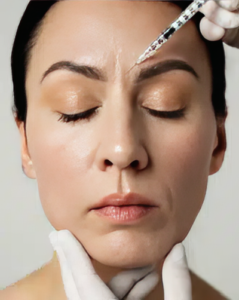“Migraine Botox” refers to the use of botulinum toxin injections (commonly known as Botox) as a treatment for chronic migraines. Botox, a neurotoxin produced by the bacterium Clostridium botulinum, is well-known for its cosmetic use in reducing wrinkles by temporarily paralyzing facial muscles. However, it also has therapeutic applications, including the treatment of chronic migraines.
When used for migraine treatment, Botox is injected into specific areas of the head and neck. The toxin works by blocking the release of certain neurotransmitters involved in pain signaling, thereby reducing the frequency and severity of migraines. It is typically recommended for individuals who experience migraines on 15 or more days per month.
The treatment involves several injections administered approximately every 12 weeks, and it may take a few sessions before the full effects are realized. While Botox can be an effective option for some migraine sufferers, it’s not suitable for everyone, and its use should be discussed with a healthcare professional.
Botox for migraines, officially known as onabotulinumtoxinA, was approved by the U.S. Food and Drug Administration (FDA) in 2010 for the prevention of chronic migraines in adults. Chronic migraines are defined as having headaches on 15 or more days per month, with at least eight of those days meeting criteria for migraines.
Here are some key points regarding Botox treatment for migraines:
Mechanism of Action: The exact mechanism by which Botox helps alleviate migraines is not fully understood. However, it is believed that the toxin inhibits the release of certain neurotransmitters involved in pain signaling, such as substance P and glutamate. By blocking the release of these neurotransmitters, Botox may reduce the hyperexcitability of nerves involved in migraine pathophysiology.
Administration: Botox injections for migraines are typically administered by a healthcare professional, such as a neurologist or headache specialist. The injections are delivered into specific muscles of the head and neck, targeting areas believed to be involved in migraine pain generation and propagation. Common injection sites include the forehead, temples, back of the head, neck, and shoulders.
Treatment Schedule: Botox treatment for migraines usually involves a series of injections administered approximately every 12 weeks. The number of injections and dosage may vary depending on the individual’s specific symptoms and response to treatment. It may take multiple treatment sessions before the full benefits are realized.
Efficacy: Clinical trials have demonstrated that Botox treatment can significantly reduce the frequency and severity of migraines in some individuals with chronic migraines. However, the response to treatment can vary among patients. While some may experience a significant reduction in migraine days and improvement in quality of life, others may have a more modest response or no response at all.
Side Effects: Common side effects of Botox injections for migraines may include temporary pain or discomfort at the injection sites, muscle weakness, and neck stiffness. In rare cases, more serious side effects such as difficulty swallowing or breathing, vision problems, or allergic reactions may occur. It’s important for patients to discuss potential risks and benefits with their healthcare provider before starting treatment.
Cost and Insurance Coverage: Botox treatment for migraines can be expensive, as it typically requires multiple injections administered by a healthcare professional. However, many insurance plans provide coverage for Botox therapy when it is prescribed for the prevention of chronic migraines. Patients should check with their insurance provider to determine coverage eligibility and any out-of-pocket costs.
Overall, Botox can be a valuable treatment option for some individuals with chronic migraines who have not responded adequately to other preventive measures. However, it’s essential for patients to work closely with their healthcare provider to determine whether Botox is appropriate for their specific condition and to monitor for any potential side effects or complications.



